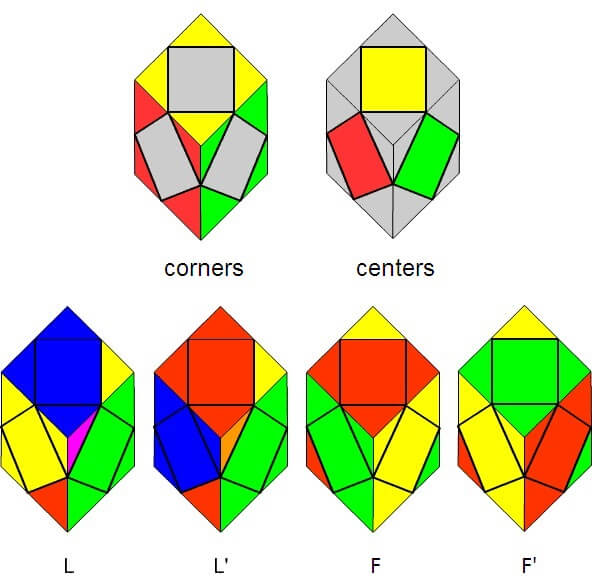Skewb
 |
 |
The Skewb is a cube-shaped puzzle. The interesting thing is that it doesn't contain the edges, it consists of only six one-colored centers and eight three-colored corners. Skewb is similar to the Pyraminx to some extent, especially in terms of turning of puzzle parts along their axes.
On this page you will find:
- Skewb - notation
- Skewb - solving of one "layer" (4 corners + 1 center)
- Skewb - solving of centers
- Skewb - solving of remaining corners
- world record videos
Skewb - notation
 |
Skewb - solving of one "layer" (4 corners + 1 center)
If the user is used to play with a Rubik's cube, turning with Skewb may look somewhat uncomfortable at first sight. However, after getting familiar with the twisting system, it shouldn't be a problem to reach a state shown on the picture below.
TIP: If you have solved one center along with 3 corners, and you can't solve the fourth one no matter what, use the following trick. Temporarily move one solved corner out of its place (do it appropriately), insert a corner to be solved, and then move the first corner back. This finesse is called a conjugation.
 |
Skewb - solving of centers
Turn a Skewb 180 degrees towards you (or the opposite direction) and look at the top center color. If it is the same as the color of solved (bottom) corners, reach the state as shown on the picture below by turning the puzzle as a whole.
 |
Use a commutator to place the top center where it belongs. That can be done by moves L F' L' F, for example.
If the color of the top center doesn't match with the color of solved corners - thus previously outlined technique can not be applied - use above mentioned commutator to get a different center at the top center position.
Then it is already possible to apply a solving technique as stated in the first paragraph of this step, and solve all centers.
Skewb - solving of remaining corners
Three situations/cases can occur in the third (and also last) solving step. First one is represented by a solved puzzle, meaning that after finishing the second step the upper corners are solved by themselves. Remaining two cases are illustrated on the picture below.
 |
As it can be seen, if the L F' L' F commutator is executed once, it influences (permutes) the centers (with an unused side effects). If it is executed twice, the centers will get back to their former places and the corners are being affected (oriented) instead.
World record videos
As a football has FIFA and athletics has IAAF, also the Skewb has some sort of board that organizes the competitions worldwide. It is WCA - World Cube Association. Thus it can be officially competed in a solving of the Skewb. It is competed in two formats: single fastest solve of the puzzle and average solve. As an average, five consecutive times of one round are taken, the best and the worst time is not considered and from the remaining three times an arithmetic mean is calculated.
| event: Skewb single solve | ||
| name: Andrew Huang (Australia) | ||
| result: 0.93 s | ||
| scramble: available upon request | ||
| solution: available upon request | ||
| puzzle brand: perhaps QiYi MoFangGe X-Man Design Wingy | ||
| solving method: God's algorithm | ||
| personal opinion on used method: see below | ||
| competition: WCA World Championship; 11-14. 7. 2019; Australia |
| event: Skewb average solve | ||
| name: Łukasz Burliga (Poland) | ||
| result: 2.03 s | ||
| scrambles: available upon request | ||
| solutions: available upon request | ||
| puzzle brand: MoYu M | ||
| solving method: two-step | ||
| personal opinion on used method: see below | ||
| competition: CFL Santa Claus Cube Race; 16-17. 12. 2017; Poland |
Spoludržitelem světového rekordu v průměrném složení je se shodným časem 2.62 vteřin i Polák Łukasz Burliga.<--> If you find a so-called speedcubing interesting, check out an article about where to buy a Skewb, what brand is the best and how to solve it faster.
Personal opinion on methods used in the world records
Skewb:
Skewb, similarly to Pyraminx, is algorithmically quite easily solvable puzzle. Hence it was only a matter of time when someone solves it with an absurdly fast God's algorithm.
Currently there are three basic methods for speedsolving: two-step method (solving of at least one layer; solving of the rest), three-step/Kirjava-Meep method (solving of a face; solving of corners; solving of centers) and four-step/Ranzha method. Method details can be found elsewhere. Three-step (and four-step) method is more move-consuming in comparison with a two-step one, however, it is more user-friendly in terms of the number of algorithms. Generally speaking, one can not rely on only one method when speedsolving the Skewb, the methods need to be changed/picked in dependence on a scramble.